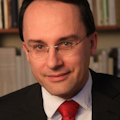Zeiss: A quiet change after ten successful years
It is one of the oldest yet most successful companies in optics and photonics in the world, named after its founder Carl Zeiss. As announced last September, Zeiss’ President and CEO Michael Kaschke handed over to Karl Lamprecht on April 1st.
While there is not much to say about this smooth transition beyond a notice from last year, it is well worth a look at Zeiss and its success story. Carl Zeiss founded a workshop in Jena, Germany, in 1846. His startup became successful with microscopes. He joined forces with physicist Ernst Abbe and chemist Otto Schott to build a list of precision optical devices, making the brand Zeiss known all over the world.
Within the 1990s the company had to cope with a number of problems: After the German re-unification, the company had to integrate the Western facilities in Oberkochen and the Eastern part in Jena. This came at a time, when the company had to deal with a recession and internal problems. In a 2012 interview Kaschke said: "We had zero equity and zero liquidity. Zeiss was financed by good business at Schott." Zeiss and Schott have the same owner – the Carl Zeiss foundation. So Zeiss went through a difficult transition process until about 2000.
In 2001, the pension plan of the Carl Zeiss foundation was opened for all German sites. That was a point that can be seen as the formal success of the integration of the different German sites. Today, Zeiss sees itself as a global network, where the local sites are just knots within an international community. There, for example, they try to unite Asian spirit and German culture as a strategic advantage. This ambition was one reason to start the Zeiss Innovation Center in Shanghai in 2011. “ZEISS can use its German roots to its advantage in China, and draw on its connections in both countries,” says Hexin Wang, one of the founding managers of the center, in an interview in 2017.
On the economic side, the years after 2000 saw both, the telecom crisis with dramatic drops at the stock market and strong investments into the semiconductor manufacturing technology (SMT) business of Zeiss. A new factory for lithographic optics (i.e. systems used for making semiconductor chips) was completed in 2006 – a risky bet with a € 450 million investment into a volatile market. But it became a billion dollar success story. As did the medical business which was strengthened with the formation of the Carl Zeiss Meditec AG in 2002.
So, diversification is one of the reasons for success of the Zeiss group in recent years. While the market for semiconductor equipment still goes up and down more than 25%, the other three segments can compensate if needed. It was under Kaschke’s reign that all four segments of the group (SMT, Industrial quality & research, Medical technology, Consumer markets) reached more than one billion revenue each.
From Jena to Oberkochen
Michael Kaschke took over as President and CEO in 2010. Before that, he had collected experience in several positions within the company: He managed the medical technology business for some critical years, and he served as CFO of the group, to name but a few of his engagements since he had joined Zeiss in 1992.
In 2020, the German business magazine brandeins characterized him as a truly exceptional manager. A statement that may hold true in several ways. At first, he is one of the very few East-Germans who made it up to the top level of German management. Second, throughout his whole career he was well known for his deep understanding of scientific and technical details. In fact, he could have started a scientific career as well. He had completed a PhD in physics at the Friedrich Schiller University in Jena in 1986 where his fellow students described him as a brilliant physicist. But when the wall came down he went to America and joined the ibm labs at Yorktown Heights for two years.
His talents may have helped him to not only understand complex scientific, but also financial problems. Foremost, it matches perfectly with the strategic core of Zeiss: Converting latest technology into successful products, the idea that made Carl Zeiss great. And it needed a leader like Kaschke to bring this spirit into the 21rst century. For example, it was 2016 when Zeiss started its own scientific symposium. Artificial intelligence in optics or the quantum world were topics of this conference. And this was not “l’art pour l’art” – digitization became an integral part of the strategy, laid down in the “ZEISS Agenda 2020 – Customer, Competitive, Digital and Team”.
2019, after leading the executive board of Zeiss almost ten years, Kaschke had an impressive record to show: 10 years of growth towards a revenue of € 6.4 billion, more than 30.000 employees in more than 50 countries around the world. In his reign, Zeiss had reached milestones such as bringing EUV optics to market, making OCT the gold standard in ophthalmology or bringing 3D-superresolution microscopy to the researchers. Seen from a distance, it was the appreciation of latest scientific developments, an excellent internal and external communication as well as a healthy diversification policy that brought Zeiss to where it stands today.
Karl Lamprecht, a native Austrian takes over a company in good shape. “Seeing beyond” is their corporate claim. By doing right that, Zeiss has successfully extended the tradition of making precision optics (and much more) from the 19th to the 21rst century. A remarkable achievement.
About the Author
Andreas Thoss
Contributing Editor, Germany
Andreas Thoss is the Managing Director of THOSS Media (Berlin) and has many years of experience in photonics-related research, publishing, marketing, and public relations. He worked with John Wiley & Sons until 2010, when he founded THOSS Media. In 2012, he founded the scientific journal Advanced Optical Technologies. His university research focused on ultrashort and ultra-intense laser pulses, and he holds several patents.

